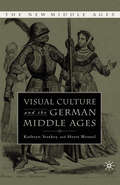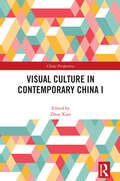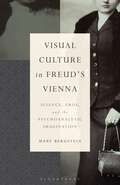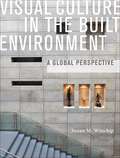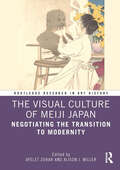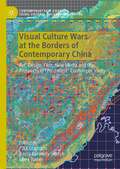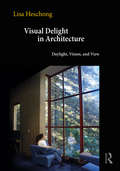- Table View
- List View
Visual Culture and the German Middle Ages (The New Middle Ages)
by K. StarkeyThis multi-disciplinary collection of essays draws on various theoretical approaches to explore the highly visual nature of the Middle Ages and expose new facets of old texts and artefacts. The term 'visual culture' has been used in recent years to refer to modern media theory, film, modern art and other contemporary representational forms and functions. But this emphasis on visuality is not only a modern phenomenon. Discourses on visual processes pervade the works of medieval secular poets, theologians, and scholastics alike. The Middle Ages was a highly visual society in which images, objects, and performance played a dominant communicative and representational role in both secular and religious areas of society. The essays in this volume, which present various perspectives on medieval visual culture, provide a critical historical basis for the study of visuality and visual processes.
Visual Culture Approaches to the Selfie (Routledge History of Photography)
by Derek Conrad MurrayThis collection explores the cultural fascination with social media forms of self-portraiture, "selfies," with a specific interest in online self-imaging strategies in a Western context. This book examines the selfie as a social and technological phenomenon but also engages with digital self-portraiture as representation: as work that is committed to rigorous object-based analysis. The scholars in this volume consider the topic of online self-portraiture—both its social function as a technology-driven form of visual communication, as well as its thematic, intellectual, historical, and aesthetic intersections with the history of art and visual culture. This book will be of interest to scholars of photography, art history, and media studies.
Visual Culture Approaches to the Selfie (Routledge History of Photography)
by Derek Conrad MurrayThis collection explores the cultural fascination with social media forms of self-portraiture, "selfies," with a specific interest in online self-imaging strategies in a Western context. This book examines the selfie as a social and technological phenomenon but also engages with digital self-portraiture as representation: as work that is committed to rigorous object-based analysis. The scholars in this volume consider the topic of online self-portraiture—both its social function as a technology-driven form of visual communication, as well as its thematic, intellectual, historical, and aesthetic intersections with the history of art and visual culture. This book will be of interest to scholars of photography, art history, and media studies.
Visual Culture: Images and Interpretations (PDF)
by Norman Bryson Michael Ann Holly Keith P. F Moxey"We can no longer see, much less teach, transhistorical truths, timeless works of art, and unchanging critical criteria without a highly developed sense of irony about the grand narratives of the past," declare the editors, who also coedited Visual Theory: Painting and Interpretation (1990). The field of art history is not unique in finding itself challenged and enlarged by cultural debates over issues of class, ethnicity, nationality, sexual orientation, and gender. Visual Culture assembles some of the foremost scholars of cultural studies and art history to explore new critical approaches to a history of representation seen as something different from a history of art. CONTRIBUTORS: Andres Ross, Michael Ann Holly, Mieke Bal, David Summers, Constance Penley, Kaja Silverman, Ernst Van Alphen, Norman Bryson, Wolfgang Kemp, Whitney Davis, Thomas Crow, Keith Moxey, John Tagg, Lisa Tickner.
Visual Culture in Contemporary China I (China Perspectives)
by Zhou XianAs the first volume of a two-volume set that examines the interaction between social transformation and visual culture in contemporary China, this book explores the visual construction of popular culture, avant-garde art, and grassroots media culture. Drawing on an approach of Marxist historic materialism and academic resources of sociology, communication, and art, this study of contemporary China’s visual culture emphasizes two inter-related aspects – the visual construction of society and the social construction of the visual. It seeks to unravel how visual culture is produced and constructed, as well as how it reflects the profound social transformation and reshapes people’s understanding and experience of modernization. In this volume, the contributors revisit popular culture, avant-garde art, and grassroots media culture in contemporary China, analyzing the visual image and representation, and visual culture’s role in social construction. In doing so, the book also reveals the cultural tension of contemporary China, in which the visual aspect figures prominently. This book will serve as an essential read for scholars and students of China studies and cultural studies, as well as all levels of readers interested in visual culture in contemporary China.
Visual Culture in Contemporary China I (China Perspectives)
As the first volume of a two-volume set that examines the interaction between social transformation and visual culture in contemporary China, this book explores the visual construction of popular culture, avant-garde art, and grassroots media culture. Drawing on an approach of Marxist historic materialism and academic resources of sociology, communication, and art, this study of contemporary China’s visual culture emphasizes two inter-related aspects – the visual construction of society and the social construction of the visual. It seeks to unravel how visual culture is produced and constructed, as well as how it reflects the profound social transformation and reshapes people’s understanding and experience of modernization. In this volume, the contributors revisit popular culture, avant-garde art, and grassroots media culture in contemporary China, analyzing the visual image and representation, and visual culture’s role in social construction. In doing so, the book also reveals the cultural tension of contemporary China, in which the visual aspect figures prominently. This book will serve as an essential read for scholars and students of China studies and cultural studies, as well as all levels of readers interested in visual culture in contemporary China.
Visual Culture in Freud's Vienna: Science, Eros, and the Psychoanalytic Imagination (Psychoanalytic Horizons)
by Professor Emerit Mary BergsteinVisual Culture in Freud's Vienna shows how photography and film in turn-of-the-century Vienna (the birthplace of psychoanalysis) not only reflected modernist ideas already in force, but helped to bring into being what might be referred to as a “psychoanalytic imagination.”Mary Bergstein demonstrates that visual images not only illustrated, but also engendered ways of seeing social, psychological, and scientific ideas during a formative time in the creation and development of psychoanalysis and the modern age. Indeed, she argues that visual culture initiated significant aspects of psychoanalytic thought.Visual Culture in Freud's Vienna examines a variety of visual materials and texts, ranging from scientific illustrations to popular "low culture" and even forms of erotica, including film. Attention is also given to women's dresses and shoes in a social context and as they are represented in photography and circulated as fetish objects.Bergstein maintains a commitment to women's history and feminist inquiry throughout, particularly in her final chapter, which is devoted to the representations of women in the erotic photography and film. Visual Culture in Freud's Vienna is well illustrated with images drawn from the sources discussed and makes a significant contribution to our understanding of modernism and psychoanalysis.
Visual Culture in the Built Environment: A Global Perspective
by Susan WinchipVisual Culture in the Built Environment: A Global Perspective provides an integrated survey of global interior environments and architecture, explaining significant design styles and movements from the mid-19th century to the present day. In addition to learning the characteristics and designers of a particular style or movement, students will learn how and why interior environments and architecture develop, including the impact of cultural and political events. In reflecting the emerging field of Visual Culture studies, this textbook expands upon traditional approaches to studying the history of interior environments and architecture by presenting content within the global interdisciplinary context of the arts, politics, technology, business, and economics.
Visual Culture in the Northern British Archipelago: Imagining Islands (British Art: Histories and Interpretations since 1700)
by Ysanne Holt David Martin-Jones Owain JonesThis edited collection, including contributors from the disciplines of art history, film studies, cultural geography and cultural anthropology, explores ways in which islands in the north of England and Scotland have provided space for a variety of visual-cultural practices and forms of creative expression which have informed our understanding of the world. Simultaneously, the chapters reflect upon the importance of these islands as a space in which, and with which, to contemplate the pressures and the possibilities within contemporary society. This book makes a timely and original contribution to the developing field of island studies, and will be of interest to scholars studying issues of place, community and the peripheries.
Visual Culture in the Northern British Archipelago: Imagining Islands (British Art: Histories and Interpretations since 1700)
by Ysanne Holt David Martin-Jones Owain JonesThis edited collection, including contributors from the disciplines of art history, film studies, cultural geography and cultural anthropology, explores ways in which islands in the north of England and Scotland have provided space for a variety of visual-cultural practices and forms of creative expression which have informed our understanding of the world. Simultaneously, the chapters reflect upon the importance of these islands as a space in which, and with which, to contemplate the pressures and the possibilities within contemporary society. This book makes a timely and original contribution to the developing field of island studies, and will be of interest to scholars studying issues of place, community and the peripheries.
The Visual Culture of al-Andalus in the Christian Kingdoms of Iberia: Ninth to Thirteenth Centuries (Routledge Research in Art History)
by Inés MonteiraThis book addresses the reception of Islamic visual culture by the northern Iberian kingdoms, by systematically comparing works of art from both sides and fleshing out their historical context.This study includes figurative and iconographic motifs, architectural forms, and even the spolia from constructions and Arabic inscriptions that were embedded in Christian buildings. The Islamic visual culture of al-Andalus was often transformed as it was recreated by Christian hands, bringing to the fore various nuances in the relationship between the two religious communities. Artistic transfer was conditioned by social coexistence between Christians and Muslims—both in the caliphate al-Andalus and in the northern realms—and military conflict. To approach the different ways in which Andalusi visual culture was received in the northern kingdoms, while embracing the vast diversity of case studies available, this book is divided into three thematic sections: Reinterpretation, Appropriation, and Artistic Transfers.This book will be of interest to scholars working in art history, visual culture, and medieval studies.
The Visual Culture of al-Andalus in the Christian Kingdoms of Iberia: Ninth to Thirteenth Centuries (Routledge Research in Art History)
This book addresses the reception of Islamic visual culture by the northern Iberian kingdoms, by systematically comparing works of art from both sides and fleshing out their historical context.This study includes figurative and iconographic motifs, architectural forms, and even the spolia from constructions and Arabic inscriptions that were embedded in Christian buildings. The Islamic visual culture of al-Andalus was often transformed as it was recreated by Christian hands, bringing to the fore various nuances in the relationship between the two religious communities. Artistic transfer was conditioned by social coexistence between Christians and Muslims—both in the caliphate al-Andalus and in the northern realms—and military conflict. To approach the different ways in which Andalusi visual culture was received in the northern kingdoms, while embracing the vast diversity of case studies available, this book is divided into three thematic sections: Reinterpretation, Appropriation, and Artistic Transfers.This book will be of interest to scholars working in art history, visual culture, and medieval studies.
The Visual Culture of Meiji Japan: Negotiating the Transition to Modernity (Routledge Research in Art History)
by Ayelet Zohar Alison J. MillerThis volume examines the visual culture of Japan’s transition to modernity, from 1868 to the first decades of the twentieth century. Through this important moment in Japanese history, contributors reflect on Japan’s transcultural artistic imagination vis-a-vis the discernment, negotiation, assimilation, and assemblage of diverse aesthetic concepts and visual pursuits. The collected chapters show how new cultural notions were partially modified and integrated to become the artistic methods of modern Japan, based on the hybridization of major ideologies, visualities, technologies, productions, formulations, and modes of representation. The book presents case studies of creative transformation demonstrating how new concepts and methods were perceived and altered to match views and theories prevalent in Meiji Japan, and by what means different practitioners negotiated between their existing skills and the knowledge generated from incoming ideas to create innovative modes of practice and representation that reflected the specificity of modern Japanese artistic circumstances. The book will be of interest to scholars working in art history, Japanese studies, Asian studies, and Japanese history, as well as those who use approaches and methods related to globalization, cross-cultural studies, transcultural exchange, and interdisciplinary studies.
The Visual Culture of Meiji Japan: Negotiating the Transition to Modernity (Routledge Research in Art History)
by Ayelet Zohar Alison J. J. MillerThis volume examines the visual culture of Japan’s transition to modernity, from 1868 to the first decades of the twentieth century. Through this important moment in Japanese history, contributors reflect on Japan’s transcultural artistic imagination vis-a-vis the discernment, negotiation, assimilation, and assemblage of diverse aesthetic concepts and visual pursuits. The collected chapters show how new cultural notions were partially modified and integrated to become the artistic methods of modern Japan, based on the hybridization of major ideologies, visualities, technologies, productions, formulations, and modes of representation. The book presents case studies of creative transformation demonstrating how new concepts and methods were perceived and altered to match views and theories prevalent in Meiji Japan, and by what means different practitioners negotiated between their existing skills and the knowledge generated from incoming ideas to create innovative modes of practice and representation that reflected the specificity of modern Japanese artistic circumstances. The book will be of interest to scholars working in art history, Japanese studies, Asian studies, and Japanese history, as well as those who use approaches and methods related to globalization, cross-cultural studies, transcultural exchange, and interdisciplinary studies.
The Visual Culture Reader (PDF)
by Nicholas MirzoeffTen years after the last edition, this thoroughly revised and updated third edition of The Visual Culture Reader highlights the transformed and expanded nature of globalized visual cultures. It assembles key new writings, visual essays and specially commissioned articles, emphasizing the intersections of the Web 2.0, digital cultures, globalization, visual arts and media, and the visualizations of war. The volume attests to the maturity and exciting development of this cutting-edge field. Fully illustrated throughout, The Reader features an introductory section tracing the development of what editor Nicholas Mirzoeff calls "critical visuality studies." It develops into thematic sections, each prefaced by an introduction by the editor, with an emphasis on global coverage. Each thematic section includes suggestions for further reading. Thematic sections include: Expansions War and Violence Attention and Visualizing Economy Bodies and Minds Histories and Memories (Post/De/Neo)Colonial Visualities Media and Mediations Taken as a whole, these 47 essays provide a vital introduction to the diversity of contemporary visual culture studies and a key resource for research and teaching in the field. Contributors: Ackbar Abbas, Morana Alac, Malek Alloula, Ariella Azoulay, Zainab Bahrani, Jonathan L. Beller,Suzanne Preston Blier, Lisa Cartwright, Dipesh Chakrabarty, Wendy Hui Kyong Chun, Beth Coleman, Teddy Cruz, René Descartes, Faisal Devji, Henry Drewal, Okwui Enwezor, Frantz Fanon, Allen Feldman, Mark Fisher, Finbarr Barry Flood, Anne Friedberg, Alex Galloway, Faye Ginsburg, Derek Gregory, J. Jack Halberstam, Donna Haraway, Brian Holmes, Amelia Jones, Georgina Kleege, Sarat Maharaj, Brian Massumi, Carol Mavor, Tara McPherson, Nicholas Mirzoeff, Timothy Mitchell, W. J. T. Mitchell, Naeem Mohaiemen, Fred Moten, Lisa Nakamura, Trevor Paglen, Lisa Parks, Sumathi Ramaswamy, Jacques Rancière, Andrew Ross, Terence E. Smith, Marita Sturken, Paolo Virno, Eyal Weizman
Visual Culture Wars at the Borders of Contemporary China: Art, Design, Film, New Media and the Prospects of “Post-West” Contemporaneity (Contemporary East Asian Visual Cultures, Societies and Politics)
by Paul Gladston Beccy Kennedy-Schtyk Ming TurnerThis edited collection brings together essays that share in a critical attention to visual culture as a means of representing, contributing to and/or intervening with discursive struggles and territorial conflicts currently taking place at and across the outward-facing and internal borders of the People’s Republic of China. Elucidated by the essays collected here for the first time is a constellation of what might be described as visual culture wars comprising resistances on numerous fronts not only to the growing power and expansiveness of the Chinese state but also the residues of a once pervasively suppressive Western colonialism/imperialism. The present volume addresses visual culture related to struggles and conflicts at the borders of Hong Kong, the South China Sea and Taiwan as well within the PRC with regard the so-called “Great Firewall of China” and differences in discursive outlook between China and the West on the significances of art, technology, gender and sexuality. In doing so, it provides a vital index of twenty-first century China’s diversely conflicted status as a contemporary nation-state and arguably nascent empire.
Visual Cultures (PDF)
by James ElkinsVisual Cultures is the first study of the place of visuality and literacy in specific nations around the world, and includes authoritative, insightful essays on the value accorded to the visual and the verbal in Japan, Poland, China, Russia, Ireland and Slovenia. The content is not only analytic, but also historical, tracing changes in the significance of visual and verbal literacy in each nation. Visual Cultures also raises and explores issues of national identity, and provides a wealth of information for future research. Visual Cultures will appeal to those with an interest in visual studies, cultural studies, postcolonial theory, area studies, subaltern studies, political theory, art history and art criticism.
Visual Data Mining: Theory, Techniques and Tools for Visual Analytics (Lecture Notes in Computer Science #4404)
by Simeon Simoff Michael H. Böhlen Arturas MazeikaVisual Data Mining—Opening the Black Box Knowledge discovery holds the promise of insight into large, otherwise opaque datasets. Thenatureofwhatmakesaruleinterestingtoauserhasbeendiscussed 1 widely but most agree that it is a subjective quality based on the practical u- fulness of the information. Being subjective, the user needs to provide feedback to the system and, as is the case for all systems, the sooner the feedback is given the quicker it can in?uence the behavior of the system. There have been some impressive research activities over the past few years but the question to be asked is why is visual data mining only now being - vestigated commercially? Certainly, there have been arguments for visual data 2 mining for a number of years – Ankerst and others argued in 2002 that current (autonomous and opaque) analysis techniques are ine?cient, as they fail to - rectly embed the user in dataset exploration and that a better solution involves the user and algorithm being more tightly coupled. Grinstein stated that the “current state of the art data mining tools are automated, but the perfect data mining tool is interactive and highly participatory,” while Han has suggested that the “data selection and viewing of mining results should be fully inter- tive, the mining process should be more interactive than the current state of the 2 art and embedded applications should be fairly automated . ” A good survey on 3 techniques until 2003 was published by de Oliveira and Levkowitz .
Visual Delight in Architecture: Daylight, Vision, and View
by Lisa HeschongVisual Delight in Architecture examines the many ways that our lives are enriched by the presence of natural daylight and window views within our buildings. It makes a compelling case that daily exposure to the rhythms of daylight is essential to our health and well-being, tied to the very genetic foundations of our physiology and cognitive function. It describes all the subtlety, beauty, and pleasures of well-daylit spaces and attractive window views, and explains how these are woven into the fabric of both our everyday sensory experience and enduring cultural perspectives. All types of environmental designers, along with anyone interested in human health and well- being, will fi nd new insights offered by Visual Delight in Architecture. The book is both accessible and provocative, full of personal stories and persuasive research, helping designers to gain a deeper understanding of the scientific basis of their designs, scientists to better grasp the real-world implications of their work, and everyone to more fully appreciate the role of windows in their lives.
Visual Delight in Architecture: Daylight, Vision, and View
by Lisa HeschongVisual Delight in Architecture examines the many ways that our lives are enriched by the presence of natural daylight and window views within our buildings. It makes a compelling case that daily exposure to the rhythms of daylight is essential to our health and well-being, tied to the very genetic foundations of our physiology and cognitive function. It describes all the subtlety, beauty, and pleasures of well-daylit spaces and attractive window views, and explains how these are woven into the fabric of both our everyday sensory experience and enduring cultural perspectives. All types of environmental designers, along with anyone interested in human health and well- being, will fi nd new insights offered by Visual Delight in Architecture. The book is both accessible and provocative, full of personal stories and persuasive research, helping designers to gain a deeper understanding of the scientific basis of their designs, scientists to better grasp the real-world implications of their work, and everyone to more fully appreciate the role of windows in their lives.
The Visual Dictionary of Architecture (Visual Dictionaries)
by Gavin Ambrose Paul Harris Sally StoneThe Visual Dictionary of Architecture is a comprehensive guide to the numerous terms associated with, and used within, the field of architecture.Over 250 architectural terms are explained and contextualised in this handy text, with concise definitions accompanied by illustrations and examples taken from historical and contemporary architecture.The dictionary covers traditional terms still in current usage, as well as modern terminology such as blobtecture and McMansion. It also defines a wide variety of practical terms, such as belfry, cladding and rotunda, and movements and styles including Deconstructivism, Functionalism and Modernism.
A Visual Dictionary of Architecture
by Francis D. ChingThe classic, bestselling reference on architecture now revised and expanded! An essential one-volume reference of architectural topics using Francis D.K. Ching's signature presentation. It is the only dictionary that provides concise, accurate definitions illustrated with finely detailed, hand-rendered drawings. From Arch to Wood, every concept, technology, material and detail important to architects and designers are presented in Ching's unique style. Combining text and drawing, each term is given a minimum double-page spread on large format trim size, so that the term can be comprehensively explored, graphically showing relations between concepts and sub-terms A comprehensive index permits the reader to locate any important word in the text. This long-awaited revision brings the latest concepts and technology of 21st century architecture, design and construction to this classic reference work It is sure to be by the side of and used by any serious architect or designer, students of architecture, interior designers, and those in construction.
The Visual Dictionary of Fashion Design (Visual Dictionaries)
by Gavin Ambrose Paul HarrisThe Visual Dictionary of Fashion Design is a comprehensive guide to the numerous terms associated with, and used within, the field of fashion.Over 250 terms are explained and contextualised, with concise definitions accompanied by illustrations and examples taken from traditional and contemporary fashion design.The dictionary covers traditional terms still in current usage, as well as modern terminology such as Tank top and Militaria. It also defines a wide variety of practical terminology, such as Appliqué, Block printing, Flax, Logo, Silhouette and Tailoring, as well as conceptual expressions including Postmodernism, Juxtaposition and Zeitgeist.
The Visual Dictionary of Graphic Design (Visual Dictionaries)
by Gavin Ambrose Paul HarrisThe Visual Dictionary of Graphic Design is a comprehensive guide to the numerous terms used within graphic design and associated disciplines.Over 250 terms are explained and contextualized, with concise definitions accompanied by illustrations and examples taken from historical and contemporary graphic design.The dictionary covers traditional practice and process terms as well as modern terminology. It also defines a wide variety of practical terms, such as Perfect binding, Deboss and Strikethrough, as well as movements and styles including Surrealism, Psychadelia and Postmodernism.
The Visual Dictionary of Graphic Design (Visual Dictionaries)
by Gavin Ambrose Paul HarrisThe Visual Dictionary of Graphic Design is a comprehensive guide to the numerous terms used within graphic design and associated disciplines.Over 250 terms are explained and contextualized, with concise definitions accompanied by illustrations and examples taken from historical and contemporary graphic design.The dictionary covers traditional practice and process terms as well as modern terminology. It also defines a wide variety of practical terms, such as Perfect binding, Deboss and Strikethrough, as well as movements and styles including Surrealism, Psychadelia and Postmodernism.
